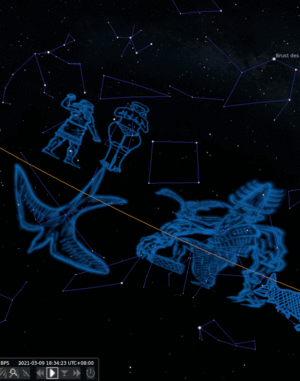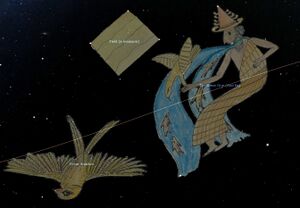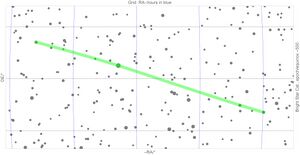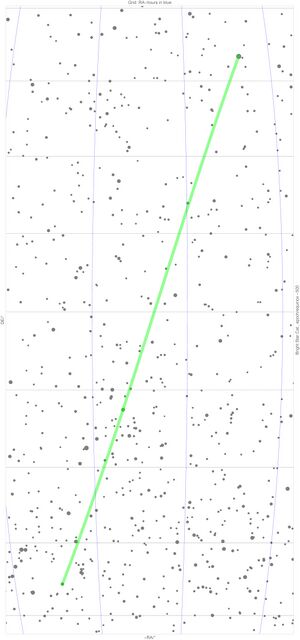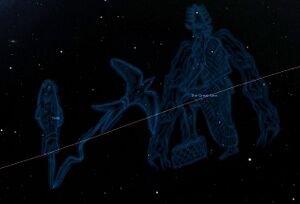SIM.MAḪ: Difference between revisions
DavidHilder (talk | contribs) No edit summary |
|||
| (One intermediate revision by one other user not shown) | |||
| Line 1: | Line 1: | ||
[[File:Psc-And-Aqr grp-GIF engl.gif|alt=Andromeda, Pisces and adjacent constellation in their transformation.|thumb|Andromeda, Pisces and adjacent constellation in their transformation (animated GIF).]] |
[[File:Psc-And-Aqr grp-GIF engl.gif|alt=Andromeda, Pisces and adjacent constellation in their transformation.|thumb|Andromeda, Pisces and adjacent constellation in their transformation (animated GIF).]] |
||
Babylonian constellation that has undergone huge transformations: the original Giant Swallow was turned into a Swallow-Fish and into two fish connected with a ribbon. |
Babylonian constellation that has undergone huge transformations: the original Giant Swallow was turned into a Swallow-Fish and into two fish connected with a ribbon. It is located in the area of modern [[Pisces]]. |
||
==Dictionary== |
==Dictionary== |
||
| Line 51: | Line 51: | ||
* (2) Dates of heliacal risings: 'on the 15th day of tebet' (I iii 7), see (Kurtik k10) KAK.SI.SA<sub>2</sub>. |
* (2) Dates of heliacal risings: 'on the 15th day of tebet' (I iii 7), see (Kurtik k10) KAK.SI.SA<sub>2</sub>. |
||
* (3) Intervals between dates of heliacal risings: TA KUR ša<sub>2</sub> <sup>mul</sup>UD. KA.DUḪ.A 30 UD<sup>meš</sup> ana KUR ša<sub>2</sub> <sup>mul</sup>SIM.MAḪ / TA KUR ša<sub>2</sub> <sup>mul</sup>SIM.MAḪ 20 UD<sup>meš</sup> ana KUR ša<sub>2</sub> <sup>mul</sup>AŠ.IKU "30 days from the rising of the Demon with the Gaping Mouth to the rising of the Swallow. 20 days from the rising of the Swallow to the rising of Field" (I iii 40-41). |
* (3) Intervals between dates of heliacal risings: TA KUR ša<sub>2</sub> <sup>mul</sup>UD. KA.DUḪ.A 30 UD<sup>meš</sup> ana KUR ša<sub>2</sub> <sup>mul</sup>SIM.MAḪ / TA KUR ša<sub>2</sub> <sup>mul</sup>SIM.MAḪ 20 UD<sup>meš</sup> ana KUR ša<sub>2</sub> <sup>mul</sup>AŠ.IKU "30 days from the rising of the Demon with the Gaping Mouth to the rising of the Swallow. 20 days from the rising of the Swallow to the rising of Field" (I iii 40-41). |
||
* (4) Culminations and simultaneous heliacal sunrises: culmination of Standing Gods, the Swallow rises (I iv 28), see (Kurtik d10) DINGIR.GUB.BA<sup>meš</sup>. |
* (4) Culminations and simultaneous heliacal sunrises: culmination of Standing Gods, the Swallow rises (I iv 28), see (Kurtik d10) [[DINGIR.GUB.BA|<sup>mul</sup>DINGIR.GUB.BA<sup>meš</sup>]]. |
||
* (5) Stars "in the path of the Moon": <sup>mul</sup>SIM.MAḪ, after <mul>KUN<sup>meš</sup>, before <sup>mul</sup>A-nu-ni-tu<sub>4</sub> (I iv 36), see (Kurtik s20) Sîn [MA, 29, 45, 54, 55, 66, 68]. |
* (5) Stars "in the path of the Moon": <sup>mul</sup>SIM.MAḪ, after <mul>KUN<sup>meš</sup>, before <sup>mul</sup>A-nu-ni-tu<sub>4</sub> (I iv 36), see (Kurtik s20) Sîn [MA, 29, 45, 54, 55, 66, 68]. |
||
|[[File:Swallow+IKU Aqr stellarium .jpg|alt=Stellarium map|thumb|Giant Swallow, IKU, and Ea (The Great One), Stellarium, painting by Jessica Gullberg (2021)]] |
|[[File:Swallow+IKU Aqr stellarium .jpg|alt=Stellarium map|thumb|Giant Swallow, IKU, and Ea (The Great One), Stellarium, painting by Jessica Gullberg (2021)]] |
||
|- |
|- |
||
|"Reports." See. [ARAK, 77:1, 253:5]. Text BM 77054. See (Kurtik d10) DINGIR.GUB.BA<sup>meš</sup>. |
|"Reports." See. [ARAK, 77:1, 253:5]. Text BM 77054. See (Kurtik d10) [[DINGIR.GUB.BA|<sup>mul</sup>DINGIR.GUB.BA<sup>meš</sup>]]. |
||
| |
| |
||
|- |
|- |
||
Latest revision as of 16:15, 16 August 2024
Babylonian constellation that has undergone huge transformations: the original Giant Swallow was turned into a Swallow-Fish and into two fish connected with a ribbon. It is located in the area of modern Pisces.
Dictionary
Krebernik (2023)
Šinūn(u)tu. “swallow” (bird). mulŠi-nu-nu-tu4 (AN 2r).
Kurtik with Hilder, Hoffmann, Horowitz, Kim
var. reading: mulŠIM2.MAḪ; var. name record: mulŠIM.MAḪ; = (mul)šinūnūtu, sinuntu "Swallow"(?); constellation in western Pisces and Pegasus (Pisces + Pegasus) [G. 389; CAD Š/3, 55f.].
| Sources | Identifications |
|---|---|
Lexical texts.
|
|
Hittite Prayer to the Gods of the Night.
|
|
| EAE. See. [ABCD, 219, EAE 20 Text a: 5′; BPO 2, X 22, XI 8; Borger 1973, LB 1321 r. 11′]. | |
"Three Stars Each (Astrolabes).
|
|
"Catalog of 30 stars".
|
|
| Šumma Sîn ina tāmartīšu. See. [Koch Westenholz 1999, 161:120]. | |
MUL.APIN.
|
|
| "Reports." See. [ARAK, 77:1, 253:5]. Text BM 77054. See (Kurtik d10) mulDINGIR.GUB.BAmeš. | |
"Great Star List."
|
|
"Planisphere K 8538."
|
|
Dalbanna-text. §e.
|
|
| Uranologies
MLC 1866.
|
|
| Text W. 22281a. See u06UD.KA.DU8.A. | |
Text 36609+ rev.
|
|
"Astronomical Diaries and Related Texts".
|
|
Late astrology, magic, and the calendar.
See also: SAG.DU [...] / ša2 mulSIM.MAḪ : dDili-pat2 : SIM : s[i-nu-un-tu] "Head of [...] Swallow(?) = Venus = Venus = SIM = L[swallow]" [SpTU I, 47:19]. |
additional
II. Deity.
According to the “texts of the Bird cry”, the Swallow (šu-nu-nu-tu2mušen, sim.mumušen) is considered to be the bird of Tiamat (mušen tam-tim) as well as of dAnzû (iṣ-ṣur dZU-u2); in the latter case her cry is: e-bi-rat a.ab.ba "She who crosses the sea" [Lambert 1970, 112:9-11, 114:3; Salonen 1973, 294-295]. Thus, each of the identifications emphasize the Swallow's connection to the sea. On the other hand, the Astrolabes (BM 82923) characterize her as the "goddess of springs," see above. Prayers and rituals. (1) Hittite Prayer to the Gods of the Night, see above. (2) The ritual of "washing the mouth" (mīs pî) or "reviving" the statue-deity, see a48AŠ.GAN2.
III. Symbol.
A bird or flying fish, see a42dAnunītu, III. In the commentary on stk. 242 of Aratus' poem “Apparitions”, it is stated that the North Fish in the constellation Pisces has the head of a swallow "and therefore the Chaldeans called it the Swallow Fish" [Rossius 1992, 115; Maass 1958, 382-383]. Here, obviously, we are talking about the southern fish from the constellation Pisces. The constellation Swallow-Fish is also mentioned in a Greek horoscope dated 81 AD. [Neugeb.-Van Hoesen 1959, 22-23, 25]. Greek evidence reflects, albeit with distortions, the Mesopotamian tradition. Images of the constellation Pisces on Seleucid seals from Uruk in the form of a fish (=Anunitu) and a bird (= flying fish or Swallow), whose tails are connected by a V-shaped ribbon, see [AUWE 19, 128-12]. [AUWE 19, 128-129, 156; Kurtik 2002, 98, fig. 21; ibid., figs. 44, 45, 46].
IV. Identification.
= southern Pisces in the constellation Pisces [3. Erg., 330; HBA, 144; G. 389, I].
= southwestern Pisces + stars up to ε Pegasi [Waerden 1949, 13; 1952-53, 219; 1974, 72].
= western Pisces (Pisces W) [Weidner 1957-59, 73b].
= western fish in the constellation Pisces (Pisces) with some western parts of Pegasus (Pegasus) [BPO 2, 11, 14; Horowitz 2014, 248; Beaulieu et al. 2018, 75].
= the wings are ζ, θ and ε of Pegasus (Pegasi) and α of the Lesser Horse (Equulei); the tail corresponds to the western fish in the constellation Pisces (Pisces) [MA, 138].
= wings of Pegasus, tail western of Pisces [Mesop.Astrol., 208, App. C].
= ε, ζ, θ Pegasi, α Equulei, and the western fish in Pisces (Pisces) [ASM, 276].
V. Parts of the constellation and individual stars.
(1) DUR ša2 SIM.MAḪ, DUR SIM.MAḪ "Swallow's Ribbon" (= ε Piscium or a group of stars including this star (?) [Roughton-Steele-Walker 2004, 553, 566]); used as a "normal star" in early diaries, see above.
(2) mulsag sim.m[aḫ] "Head of the Swallow[s]" (ε Peg), see dbn text.
(3) GU2 mulsSIM.MAḪ "Swallow's neck," see below (8).
(4) Swallow's wings, see MLC 1866.
(5) Swallow's and Anunītu's tails; MUL.MEŠ ša KUN.MEŠ ša mulSIM.MAḪ u mulAn[nunīti] "Stars on the tails of Swallow and A[nunītu]" (K. 11018 r. 2), quoted in [CAD Š/3, 56a].
VI. Astrology.
Identifications:
(1) = Field; see m05MAN-ma, II 7.
(2) = Mars(?); cf. [Bezold 1920, 122:157], highly doubtful.
Predications:
(3) Rising on its own time and not on its own time; "In the month of Shabbat the Swallow (mulSIM.MAḪ) [...] if it rises on its fixed date (ina UD.DUG4.GA-ša2 KUR-ḫa): there will be obedience in the land (taš-mu-u2 ina KUR GAL2), [if it rises not on its fixed date]: there will be [...]" [BPO 2, X 22, XI 8].
(4) Lunar eclipse in Swallow; [DIŠ 30 ina K]I mulSIM.MAḪ a-di[r EŠ.BAR ID2 Pu-rat-tum u EŠ.BAR A.AB.BA : NI.TUKki] "[If the Moon] eclipses in the region of Swallow: [solution for the Euphrates River and solution for the (Land of) the Sea, var.: for Dilmun]" [ABCD, 219, BM 38164:5′], for a parallel see. [Weidner 1963, 118, MNB 1849:51].
(5) The Moon, the halo of the Swallow and Anunitu; [...d]tir.an.na nigin2-ma kimin kal ud-mi gub-iz ki [...] / [...] ud-mi gub-iz : tur3 mulsim.maḫ u mula-nu-ni-[tum ...] "[If the Moon] is surrounded by a [halo], (having the appearance of) a rainbow, var. : it stands all day (in) the region of [...] / [...] stands (all) days, it is the halo of the Swallow and Anuni[tu ...]" [Koch-Westenholz 1999, 161:119-120].
(6) The swallow gives rise to mišḫu; DIŠ mulSIM. MAḪ (glossa: mu-ul ši-im-ma-a[ḫ]) [x x x x x] / meš-ḫa [im-šu-uḫ] / ZI-ut ERIM-ni (glossa: ti-bu-ut um-ma-[ni]) [x x x x x] "If the Swallow [gives rise to] mišḫu: attack by (hostile) armies" [ARAK, 77:1-3], for a parallel see. [ACh Ištar, 34:6], and also: ulSIM.MAḪ MEŠ.U im-šu4-uḫ [...] [SpTU I, 84:4; CAD Š/3, 56a]. See also [ACh Suppl., 54:11].
(7) The swallow is dark; múlSIM.MAḪ a-dir 30 ina EN.NUN MURUB4.BA AN.MI GAR-ma "(If) the swallow is dark, (it means): The moon is darkened in the middle watch" (AO 6455:1) [TU, 11:1].
(8) Mercury and Mars stand in the Swallow (observ.); [mul]UDU.IDIM.GUD.UD ina ŠA3 mulSIM.MAḪ GUB-ma "Mercury stands in the Swallow" [ARAK, 253:5′]; Ṣalbatānu ina ŠA3 GU2 mulSIM.MAḪ GUB-ma "Mars stands on the Swallow's neck" (Rm. 2548+:1′), quoted in [CAD Š/3, 56a].
(9) Saturn stands within the Swallow or Anunitu; see k24KU6, V 10.
See also: [...mul]ši-nu-nu-tu2 ina i-di mulAŠ.GAN2 e-sir2 MUL ša2 KUR URIki šu2-u "[...If] the Swallow is surrounded by the Field on the side : the star Ura it.." [ACh Suppl., 54:12]; [mulSI]M.MAḪ GUB-ma "[Sw]allow stands" [ACh Ištar, 28:31], [...] dSIM.MAḪ u da-nu-ni-[tum] "[...] Swallow and Anunitu [...]" [ACh Ištar, 29:3].
Historical Dictionaries
| Kurtik (2022) | Gössmann (1950) |
|---|---|
| вар. чтения: mulŠIM2.MAḪ; вар. записи названия: mulŠIM.MAḪ; = (mul)šinūnūtu, sinuntu «Ласточка»(?); созвездие в западной части Рыб и Пегаса (Pisces + Pegasus) [G. 389; CAD Š/3, 55f.]. | Example |
| I. Источники.
Лексич. тексты. (1) Серия Urra XXII: mulsim.maḫ = si-nu-un-tu4 [Emar VI/4, 151:180], mulsim.maḫmušen = si-nun-tum/tu2 [SpTU III, 114A v 52], [mu]lsim.maḫ = si-nun-tum [Cavigneaux 1979, 134, 17:24; Bloch-Horowitz 2015, 110:309ʹ]. (2) Серия Ḫg. B VI: mul ídburanun = si-nun-tum = […] «Евфрат = Ласточка» [MSL XI, 40:23]. Хеттская молитва ночным богам. mulŠa-am-ma-aḫ [KUB IV, 47 r. 45; BPO 2, 2:14; Van der Toorn 1985, 130:45]. ЕАЕ. См. [ABCD, 219, EAE 20 Text a: 5'; BPO 2, X 22, XI 8; Borger 1973, LB 1321 r. 11′]. «Астролябии». Astrolabe P. Месяц шабату, звезды Ану, 80 [Pinches 1900, 575]. Astrolabe B. (1) Список (12´3): mul ša dal.ba.an mulšu.gi / u3 dA-nim gub-zu / mulsim.maḫ […] «Созвездие, которое между Стариком и Ану стоит, (это) Ласточка […]» (B ii 15–17); параллель см. [BPO 2, III 32–32a; Oelsner–Horowitz 1997–98, Anu 6 + comment.]. (2) Cписок (3´12): [itiziz2] … mulsim.maḫ šu-ut dA-nim «[Шабату]: … Ласточка (на пути) Ану (восходит)» (C ii 11). (3) Список (восход–заход=6m): восход — шабату, заход — абу [KAV 218, C 22, 33; Horowitz 2014, 38, 40], см. n49NU.MUŠ.DA. BM 82923. Шабату, звезды Ану: mulSIM.MAḪ // 1,20 // DINGIR-at nag-bi «Ласточка // 80 // Богиня источников» [Walker–Hunger 1977, 30:32]. BM 34713. Аддару, звезды Ану [LBAT, 1499:12], см. k24KU6. Звезды Эа, Ану и Энлиля. a) Список 12 звезд Ану (№ 1): mul[sim].maḫ [CT 33, 9 r. 8; MCG, 176]. b) Список 12 звезд Ану (№ 10): mulsim.maḫ [TCL 6, 13; Rochberg-Halton 1987b, 212]. «Каталог 30 звезд». Anu 6. [MUL SA5 ša DAL.BA.AN (A: b[i?-ri-it]) mu]lši-bi u dA-nim GUB-zu múlši-nu-nu-tum «[Красная звезда, которая стоит между] Стариком и Ану, (это) Ласточка» (A. 20, B. 21) [Oelsner–Horowitz 1997–98, 178]. Šumma Sîn ina tāmartīšu. См. [Koch Westenholz 1999, 161:120]. MUL.APIN. (1) Звезды Ану (№ 2): MUL ša2 ina IGI-it mulAŠ.IKU GUB-zu mulŠi-nu-nu-tu4 «Звезда, которая стоит перед Полем, Ласточка» (I i 41), параллель см. MLC 1866. (2) Даты гелиакических восходов: «15-го тебету» (I iii 7), см. k10KAK.SI.SA2. (3) Интервалы между датами гелиакических восходов: TA KUR ša2 mulUD.KA.DUḪ.A 30 UDmeš ana KUR ša2 mulSIM.MAḪ / TA KUR ša2 mulSIM.MAḪ 20 UDmeš ana KUR ša2 mulAŠ.IKU «30 дней от восхода Демона с Разинутой Пастью до восхода Ласточки. 20 дней от восхода Ласточки до восхода Поля» (I iii 40–41). (4) Кульминации и одновременные гелиакические восходы: Стоящие Боги кульминируют, Ласточка восходит (I iv 28), см. d10DINGIR.GUB.BAmeš. (5) Звезды «на пути Луны»: mulSIM.MAḪ, после <mul>KUNmeš, перед mulA-nu-ni-tu4 (I iv 36), см. s20Sîn [MA, 29, 45, 54, 55, 66, 68]. «Рапорты». См. [ARAK, 77:1, 253:5]. Текст BM 77054. См. d10DINGIR.GUB.BAmeš. «Большой список звезд». (1) mul ídburanun = mulšim.maḫ «Евфрат = Ласточка»; (2) 12 звезд Амурру: mulsim.maḫ [Mesop.Astrol., App. B: 147, 220]. Список звезд VR 46, 1:34. mulA-nu-ni-tu4 u mulŠi-nu-nu-tu4 = ídidigna u ídburanun «Ануниту и Ласточка = Тигр и Евфрат» [HBA, 52; Wee 2016, 162–3]. «Планисфера К 8538». Сектор 1: muls[im?.maḫ] «Л[асточка]» [Koch 1989, 56 Abb. 2, 59]. Dalbanna-текст. §е. a) mulsim.maḫ (ω Psc), b) mulsag sim.m[aḫ] «Голова Ласто[чки]» (ε Peg) [Walker 1995, 36; Koch 1995, 61; ASM, 108]. Текст Nv. 10. (1) Схема интеркаляций: sim.maḫ (=ε Peg) — ведущая звезда, относительно которой производится отсчет положений AN.TA.GUB.BA звезд при их прохождении через меридиан [Donbaz–Koch 1995, 78], см. a02A.EDIN, d05DI, L04Lammu, u19UR.GI7, u20UR.GU.LA. (2) [mulsim.]˹maḫ˺ — звезда AN.TA.GUB.BA в месяце симану, см. sh17ŠU.PA. MLC 1866. [MUL ša2 ina] miḫ-rat mulIKU GUB-˹zu˺ mulSi2-˹nu˺-nu-tu2 / ˹MUŠEN˺ mulKAP.ḪI.A mut-tap-ri-iš ša2 kap-pi ˹ra˺-šu-u2 / MUL ša2 EGIR.MEŠ mulIKU GUB-zu mulA-nu-ni-tu4 na-a-ru / [mu]lSi2-nu-nu-tu4 u3 mulA-nu-ni-tu4 ina KUN.MEŠ-šu2-nu it-gu-ru-u2-ma / ˹MUL˺.MEŠ ídIDIGNA u ídBURANUNki ina ṣip-ri mulZIB / ˹ṣab-tu4˺ mulSIM.MAḪ u GU2.LA2 mulA-nu-ni-tu4 man-za-za muldil-bat «[Звезда, которая] перед Полем стоит, Ласточка: / (Это) птица, звезда с крыльями, летающая, это означает, что у нее есть крылья. / Звезда, которая позади Поля стоит, Ануниту, река. / [Лас]точка и Ануниту хвостами своими одна с другой пересекаются, / звезды Тигра и Евфрата, острия хвостов у них расположены вместе. Ласточка и вытянутая шея Ануниту – стоянка Венеры» (D i 4–9) [Beaulieu et al. 2018, 35, 39]. Текст W. 22281a. См. u06UD.KA.DU8.A. Текст 36609+ rev. Список «нормальных звезд»: DUR sim.maC «Лента Ласточки» [Roughton–Steele–Walker 2004, 551:21′, 553]. «Дневники наблюдений». В ранних дневниках упоминается созвездие Ласточка: dSAG.UŠ/dGENNA ina IGI SIM.<MAḪ> «Сатурн перед Ласточкой» [AD I, 46, No.-567:2,9], Sin ina SIM.MAḪ IGI «Луна стала видна в Ласточке» [ibid., 48, No.-567 r. 5′], а также: DUR ša2 SIM.MAḪ «Лента Ласточки» [AD I, 50, No.-567 rev. 17′, 19′], MUL2 KUR ša2 DUR SIM.MAḪ «Блестящая звезда ленты Ласточки» (= η Piscium) [AD I, 84, No.-380:5′]. Поздняя астрология, магия и календарь. (1) «Додекатемория». BM 34452+: 12 8 // 3 14 // Sin ina múlSIM.MAḪ KI / múlSIPA GUB E2 dNANŠE «Аддару 8 // симану 14 // Луна в Ласточке. Область / Праведного Пастуха Ану (=Сатурн?), место храма Нанше» [LBAT, 1586 + 1567; Hunger 1975, 41: rev. 7–8], см. также [SpTU III, 103:4]. См. также: SAG.DU […] / ša2 mulSIM.MAḪ : dDili-pat2 : SIM : s[i-nu-un-tu] «Голова […] Ласточки(?) = Венера = SIM = Л[асточка]» [SpTU I, 47:19]. II. Божество. Согласно «Текстам криков птиц» (Birdcall texts) Ласточка (šu-nu-nu-tu2mušen, sim.mumušen) считается птицей Тиамат (mušen tam-tim), а также dAnzû (iṣ-ṣur dZU-u2); в последнем случае ее крик: e-bi-rat a.ab.ba «Та, что пересекает море» [Lambert 1970, 112:9–11, 114:3; Salonen 1973, 294–295]. Таким образом, в каждом из отождествлений подчеркивается связь Ласточки с морем. С другой стороны, в «Астролябии» (BM 82923) она охарактеризована как «богиня источников», см. выше. Молитвы и ритуалы. (1) Хеттская молитва ночным богам, см. выше. (2) Ритуал «омовения рта» (mīs pî) или «оживления» статуи-божества, см. a48AŠ.GAN2. III. Символ. Птица или летающая рыба, см. a42dAnunītu, III. В комментарии к стк. 242 поэмы Арата «Явления» утверждается, что у Северной Рыбы в созвездии Рыбы голова ласточки “и поэтому халдеи называют ее Ласточкиной Рыбой” [Россиус 1992, 115; Maass 1958, 382–383]. Здесь, очевидно, речь идет о южной рыбе из созвездия Рыбы. Созвездие Ласточка-Рыба упоминается также в греческом гороскопе, датируемом 81 г. н. э. [Neugeb.–Van Hoesen 1959, 22–23, 25]. Греческие свидетельства отражают, хотя и с искажениями, месопотамскую традицию. Изображения созвездия Рыбы на печатях селевкидского времени из Урука в виде рыбы (=Ануниту) и птицы (= летающая рыба или Ласточка), хвосты которых соединены V-образной лентой см. [AUWE 19, 128–129, 156; Куртик 2002, 98, илл. 21; ibid., рис. 44, 45, 46]. IV. Отождествление. = южная Рыба в созвездии Рыбы [3. Erg., 330; HBA, 144; G. 389, I]. = юго-западная часть Рыб + звезды до ε Pegasi [Waerden 1949, 13; 1952–53, 219; 1974, 72]. = западная часть Рыб (Pisces W) [Weidner 1957–59, 73b]. = западная рыба в созвездии Рыбы (Pisces) с некоторыми западными частями Пегаса (Pegasus) [BPO 2, 11, 14; Horowitz 2014, 248; Beaulieu et al. 2018, 75]. = крылья — ζ, θ и ε Пегаса (Pegasi) и α Малого Коня (Equulei); хвост соответствует западной рыбе в созвездии Рыбы (Pisces) [MA, 138]. = крылья Пегаса, хвост западной из Рыб [Mesop.Astrol., 208, App. C]. = ε, ζ, θ Pegasi, α Equulei и западная рыба в Рыбах (Pisces) [ASM, 276]. V. Части созвездия и отдельные звезды. (1) DUR ša2 SIM.MAḪ, DUR SIM.MAḪ «Лента Ласточки» (= ε Piscium или группа звезд, включающая эту звезду (?) [Roughton–Steele–Walker 2004, 553, 566]); использовалась в качестве «нормальной звезды» в ранних дневниках, см. выше. (2) mulsag sim.m[aḫ] «Голова Ласточ[ки]» (ε Peg), см. dbn-текст. (3) GU2 mulSIM.MAḪ «Шея Ласточки», см. ниже (8). (4) Крылья Ласточки, см. MLC 1866. (5) Хвосты Ласточки и Ануниту; MUL.MEŠ ša KUN.MEŠ ša mulSIM.MAḪ u mulAn[nunīti] «Звезды на хвостах Ласточки и А[нуниту]» (K. 11018 r. 2), цит. по [CAD Š/3, 56a]. VI. Астрология. Отождествления: (1) = Поле; см. m05MAN-ma, II 7. (2) = Марс(?); см. [Bezold 1920, 122:157], крайне сомнительно. Предсказания: (3) Восход в свое и не в свое время; «В месяце шабату Ласточка (mulSIM.MAḪ) […], если она восходит в свою установленную дату (ina UD.DUG4.GA-ša2 KUR-ḫa): в стране будет послушание (taš-mu-u2 ina KUR GAL2), [если она восходит не в свою установленную дату]: в стране будет […]» [BPO 2, X 22, XI 8]. (4) Лунное затмение в Ласточке; [DIŠ 30 ina K]I mulSIM.MAḪ a-di[r EŠ.BAR ID2 Pu-rat-tum u EŠ.BAR A.AB.BA : NI.TUKki] «[Если Луна] затмила[сь в обла]сти Ласточки: [решение для реки Евфрат и решение для (Страны) Моря, вар.: для Дильмуна]» [ABCD, 219, BM 38164:5′], параллель см. [Weidner 1963, 118, MNB 1849:51]. (5) Луна, гало Ласточки и Ануниту; […d]tir.an.na nigin2-ma kimin kal ud-mi gub-iz ki […] / […] ud-mi gub-iz : tur3 mulsim.maḫ u mula-nu-ni-[tum …] «[Если Луна] окружена [гало], (имеющего вид) радуги, вар.: она стоит все дни (в) области […] / […] стоит (все) дни, это гало Ласточки и Ануни[ту …]» [Koch-Westenholz 1999, 161:119–120]. (6) Ласточка порождает mišḫu; DIŠ mulSIM.MAḪ (глосса: mu-ul ši-im-ma-a[ḫ]) [x x x x] / meš-ḫa [im-šu-uḫ] / ZI-ut ERIM-ni (глосса: ti-bu-ut um-ma-[ni]) [x x x x] «Если Ласточка [порождает] mišḫu: нападение (враждебных) армий» [ARAK, 77:1–3], параллель см. [ACh Ištar, 34:6], а также: ulSIM.MAḪ MEŠ.U im-šu4-uḫ […] [SpTU I, 84:4; CAD Š/3, 56a]. См. также [ACh Suppl., 54:11]. (7) Ласточка темная; múlSIM.MAḪ a-dir 30 ina EN.NUN MURUB4.BA AN.MI GAR-ma «(Если) Ласточка темная, (это означает): Луна в среднюю стражу затмилась» (AO 6455:1) [TU, 11:1]. (8) Меркурий, Марс в Ласточке стоят (наблюд.); [mul]UDU.IDIM.GUD.UD ina ŠA3 mulSIM.MAḪ GUB-ma «Меркурий стоит в Ласточке» [ARAK, 253:5′]; Ṣalbatānu ina ŠA3 GU2 mulSIM.MAḪ GUB-ma «Марс на шее Ласточки стоит» (Rm. 2548+:1′), цит. по [CAD Š/3, 56a]. (9) Сатурн стоит внутри Ласточки или Ануниту; см. k24KU6, V 10. См. также: […mul]ši-nu-nu-tu2 ina i-di mulAŠ.GAN2 e-sir2 MUL ša2 KUR URIki šu2-u «[…Если] Ласточка со стороны Поля окружена: звезда Ура она» [ACh Suppl., 54:12]; [mulSI]M.MAḪ GUB-ma «[Ла]сточка стоит» [ACh Ištar, 28:31], […] dSIM.MAḪ u da-nu-ni-[tum] «[…] Ласточка и Ануниту […]» [ACh Ištar, 29:3]. |
Example |
